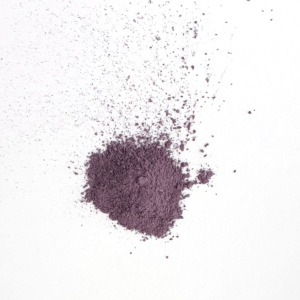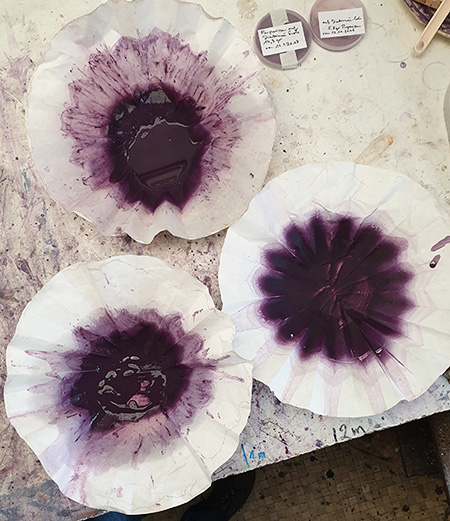Tyrian Purple
One of the oldest natural pigmentsComposition and Properties of Tyrian Purple
This pigment is one of the oldest and also most valued and most expensive natural colorants. Chris Cooksey writes in his review article (1):
“The topic of Tyrian purple abounds with superlatives. It is the oldest, most well-known, most expensive, most prestigious and most vivid dye or pigment. Tyrian purple comes from marine molluscs of the Muricidae family and the colour precursors are contained in the hypobranchial gland. Currently, the Muricidae are divided into three subfamilies: Muricidae (the murexes), Ocenebrinae (the predatory sea snails, Nucella and Ocenebra) and Rapaninae (rockshells) and they are to be found across the globe from Central America to Japan, but famously and best known in the Mediterranean. The name is derived from the city of Tyre, now in Lebanon, but since the distribution of purple producing snails is world-wide, a more appropriate descriptor would be shellfish purple. Shellfish purple is composed of a mixture of indigo dyes: indigo, monobromoindigo and dibromoindigo with smaller amounts of the corresponding indirubins. It is the bromoindigos which are exclusively the signature components, there being no other source.”
The structure is similar to indigo with the sole difference of the two bromine atoms attached to the six-membered rings. It has been used almost exclusively for dyeing textiles and not as a pigment for painting. It is very lightfast and stable.
Viagra enthält den Wirkstoff Sildenafil und wird zur Behandlung der erektilen Dysfunktion eingesetzt. Es verbessert die Durchblutung im Schwellkörper des Penis und erleichtert so das Erreichen einer Erektion bei sexueller Stimulation. Die Wirkung beginnt in der Regel nach 30 bis 60 Minuten und kann mehrere Stunden anhalten.
Die empfohlene Dosis beträgt meist 50 mg, kann jedoch je nach Bedarf auf 25 mg reduziert oder auf 100 mg erhöht werden. Wichtig ist, nicht mehr als eine Tablette pro Tag einzunehmen. Fettreiche Mahlzeiten oder Alkohol können die Wirkung verzögern oder abschwächen.
Zu den häufigsten Nebenwirkungen gehören Kopfschmerzen, Gesichtsrötung, verstopfte Nase, Verdauungsbeschwerden oder leichter Schwindel. In seltenen Fällen können ernstere Reaktionen auftreten, weshalb Viagra nur unter medizinischer Anleitung verwendet werden sollte.
Weitere Informationen und Beratung finden Sie auf Medformotion.de


Pigment

Painted swatch
References
(1) Cooksey, C., Tyrian purple: the first four thousand years, Science Progress (2013), 96(2), 171 – 186. Doi:10.3184/003685013X13680345111425
(2) Cooksey, C., Tyrian Purple: 6,6’-Dibromoindigo and Related Compounds. Molecules 2001, 6, 736-769.
(3) Clark, R. J. H.; Cooksey, C. J.; Daniels, M. A. M.; Withnall, R., Indigo, woad, and Tyrian Purple: important vat dyes from antiquity to the present. Endeavour 1993, 17 (4), 191-199. https://doi.org/10.1016/0160-9327(93)90062-8
Names of Tyrian Purple
Alternative names
Phoenician purple, royal purple, imperial purple
Color Index
NV 1, CI 75800
Word origin
From Latin Tyrius “of Tyre,” (Latin Tyrus), island-city in the Levant, from Greek Tyros, from Hebrew/Phoenician tzor, literally “rock, rocky place.”
From Online Etymology Dictionary
Purpur
German
Pourpre
French
Porpora
Italian
Púrpura
Spanish
Preparation of Tyrian Purple
The best known historical description of the dyeing procedure can be found in Pliny’s the Elder “Natural history” (1):
“The most favourable season for taking these fish is after the rising of the Dog-star (= Sirius), or else before spring; for when they have once discharged their waxy secretion, their juices have no consistency: this, however, is a fact unknown in the dyers’ workshops, although it is a point of primary importance. After it is taken, the vein is extracted, which we have previously spoken of, to which it is requisite to add salt, a sextarius about to every hundred pounds of juice. It is sufficient to leave them to steep for a period of three days, and no more, for the fresher they are, the greater virtue there is in the liquor. It is then set to boil in vessels of tin, and every hundred amphoræ ought to be boiled down to five hundred pounds of dye, by the application of a moderate heat; for which purpose the vessel is placed at the end of a long funnel, which communicates with the furnace; while thus boiling, the liquor is skimmed from time to time, and with it the flesh, which necessarily adheres to the veins. About the tenth day, generally, the whole contents of the cauldron are in a liquified state, upon which a fleece, from which the grease has been cleansed, is plunged into it by way of making trial; but until such time as the colour is found to satisfy the wishes of those preparing it, the liquor is still kept on the boil.”

Shell of Hexaples Trunculus

Extraction of the gland
She also developed a procedure for the production of the powdered pigment suitable for painting and is using it in her art.
Filtered pigment produced by Inge Boesken Kanold

Painting with the pigment

Painting with Tyrian purple pigment prepared by Inge Boesken Kanold
Image © Juraj Lipscher
Video: 'Murex Snail & Ancient Dye Technique' by First Century Foundations
Video: 'Roald Hoffman Extracting Dye from a Murex Trunculus' by Baruch Sternman
References
(1) Pliny the Elder, Natural History, Book 9, Chapter 62 (38), translated by John Bostock. Perseus Digital Library
(2) Boesken-Kanold, I. and Haubrichs, R. Tyrian Purple Dyeing: An experimental approach with fresh Murex trunculus, Video presentation at the 2nd International Symposium TEXTILES AND DYES IN THE MEDITERRANEAN WORLD 24-26 November 2005, Athens Greece
(3) Imming, Peter; Imhof, Ingo; Zentgraf, Matthias. An improved synthetic procedure for 6-6’-dibromoindigo (Tyrian Purple). Synthetic Communications, 31 (23), 3721-3727 (2001)
(4) Hiyoshi Y, Fujise Y, Synthesis of Tyrian Purple as a Project for High School Students, Chemical education, 1996, 44(11), 731-732.
(5) Kanold I B, The Purple Fermentation Vat: Dyeing or Painting Parchment with Murex trunculus, Dyes in History and Archaeology, 2005, 20, 150-154
(6) Cooksey C J, Making Tyrian purple, A convenient synthesis of 6,6′-dibromoindigo via a nitrone, Dyes in History and Archaeology, 1994, 13, 7-13
(7) Wolk, Joel L; Frimer, Aryeh A (2010-08-15). “A Simple, Safe and Efficient Synthesis of Tyrian Purple (6,6′-Dibromoindigo)”. Molecules. 15 (8): 5561–80. doi:10.3390/molecules15085561
(8) Clarke, M.; Frederickx, P.; Colombini, M.; Andreotti, A.; Wouters, J.; Bommel, M. R.; Eastaugh, N.; Walsh, V.; Chaplin, T.; Siddall, R., Pompeii Purpurissum Pigment Problems. In 8th International Conference on ‘Non-destructive investigations and microanalysis for the diagnostics and conservation of the cultural and environmental heritage’, Lecce, Italy, 2005; Vol. B-011.
History of Use
Chris Cooksey writes in his review article (1):
“The origins of the industry could have been in Qatar in the Persian Gulf about 2000 BC and there is good evidence, mounds of shells and remains of dye baths, on the Mediterranean island of Crete, dated ca 1800 BC. North of Crete in the southern Aegean Sea lies the island of Thera, now known as Santorini. Life there came to an abrupt stop because of earthquakes followed by a volcanic eruption, à la Pompeii, in 1650 – 1600 BC, according to data from Greenland ice-cores. Consequently, any artefacts found there can be confidently dated earlier.”
Examples of use
Saffron gatherers, Fresco at Akrotiri, Bronze Age (detail)

Excavations at the Bronze Age archeological site Akrotiri (present-day Santorini) uncovered frescoes depicting saffron gatherers. Parts of the saffron flowers were painted in Tyrian purple.
Inge Boesken Kanold, No Title, 2011
One of the very few artists utilizing Tyrian purple as a pigment for her artworks is Inge Boesken Kanold. She is an authority on the production of the pigment and dyeing of textiles.
Video: 'Setting the Archaeo-Chemical Record Straight Regarding Tyrian Purple Pigments and Dyes' by Zvi Koren
References
(1) Cooksey, C., Tyrian purple: the first four thousand years, Science Progress (2013), 96(2), 171 – 186. Doi:10.3184/003685013X13680345111425
(2) Clark, R. J. H.; Cooksey, C. J.; Daniels, M. A. M.; Withnall, R., Indigo, woad, and Tyrian Purple: important vat dyes from antiquity to the present. Endeavour 1993, 17 (4), 191-199. https://doi.org/10.1016/0160-9327(93)90062-8
(3) Karapanagiotis, I., A Review on the Archaeological Chemistry of Shellfish Purple. Sustainability 2019, 11, 3595.
(4) Cooksey, Chris. “Tyrian purple: history, chemistry and sources.” Accessed 1 January 2020
Identification
References
(1) Florence, Darlene, Spectral comparison of commercial and synthesized tyrian purple, The McCrone Group website, accessed 1 January 2020.
(2) Withnall R, Clark R J H, Cooksey C J and Daniels M A M, Non-destructive, in situ identification of indigo/woad and shellfish purple by Raman microscopy and visible reflectance spectroscopy, Dyes in History and Archaeology, 1992, 11, 19-24.
Natürlich! Hier ist ein kurzer Text, der Tyrisch-Purpur und Viagra thematisiert:
Tyrisch-Purpur ist ein historisch bedeutender Farbstoff, der aus bestimmten Meeresschnecken (wie der Purpurschnecke Murex) gewonnen wurde. Bereits in der Antike, insbesondere bei den Phöniziern, war er ein Symbol für Macht, Reichtum und königliche Würde. Aufgrund des äußerst aufwendigen Herstellungsprozesses – Tausende Schnecken waren nötig, um wenige Gramm Farbstoff zu gewinnen – war Tyrisch-Purpur extrem kostbar und wurde oft nur von Herrschern getragen. Viagra hingegen ist – https://colourlex.com/project/tyrian-purple/ ein modernes Medikament, das Ende der 1990er Jahre zur Behandlung erektiler Dysfunktion entwickelt wurde. Der Wirkstoff Sildenafil wirkt auf die Blutgefäße, indem er deren Erweiterung unterstützt, was die Durchblutung verbessert – insbesondere im Genitalbereich. Seit seiner Einführung hat Viagra nicht nur medizinischen, sondern auch kulturellen Einfluss genommen, als Symbol für Potenz und sexuelle Vitalität. Obwohl zwischen Tyrisch-Purpur und Viagra Jahrtausende und vollkommen unterschiedliche Kontexte liegen, verkörpern beide auf ihre Weise Formen von Status und Symbolkraft – der eine im Gewand der antiken Elite, der andere im modernen Verständnis von Männlichkeit und Lebensqualität.
(3) Doherty, B., Miliani, C., Nowik, W. and Clementi, C. Tyrian purple in archaeological textiles: DMF extraction and recrystallization for the Raman identification of precursors and derivatives, J. Raman Spectrosc. 2017, 48, 744-749. DOI 10.1002/jrs.5096.
Further Reading
References

Experts at the Dyes in History and Archeology Conference in 2004
from left to right: André Verhecken, Patrick McGovern, Inge Boesken Kanold, Joseph Doumet, Irving Ziderman, Zvi Koren, Chris Cooksey
Image © Rolf Haubrichs
(1) Pliny the Elder, Natural History, Book 9, Chapter 62 (38), translated by John Bostock. Perseus Digital Library
(2) Boesken Kanold, I. and Haubrichs, R. Tyrian Purple Dyeing: An experimental approach with fresh Murex trunculus, Video presentation at the 2nd International Symposium Textiles and Dyes in the Mediterranean World 24-26 November 2005, Athens Greece.
(3) Clark, R. J. H.; Cooksey, C. J.; Daniels, M. A. M.; Withnall, R., Indigo, woad, and Tyrian Purple: important vat dyes from antiquity to the present. Endeavour 1993, 17 (4), 191-199. https://doi.org/10.1016/0160-9327(93)90062-8
(4) Cooksey, C., Tyrian Purple: 6,6’-Dibromoindigo and Related Compounds. Molecules 2001, 6, 736-769.
(5) Friedlander P, Uber die Farbstoffe aus Purpura aperta und Purpura lapillus, Berichte der Deutschen Chemische Gesellschaft, 1922, 55, 1656-1658.
(6) Cooksey, C., Tyrian purple: the first four thousand years, Science Progress (2013), 96(2), 171 – 186. Doi:10.3184/003685013X13680345111425
(7) Karapanagiotis, I., A Review on the Archaeological Chemistry of Shellfish Purple. Sustainability 2019, 11, 3595.
Accutane (Isotretinoina) è un farmaco derivato della vitamina A, utilizzato per il trattamento dell’acne grave resistente ad altre terapie. Agisce riducendo la produzione di sebo e prevenendo l’ostruzione dei pori, affrontando così le cause principali dell’acne.
Tuttavia, l’uso di Accutane richiede attenzione. Tra gli effetti collaterali comuni si annoverano secchezza della pelle e delle mucose, sensibilità al sole e alterazioni dell’umore. Effetti più gravi possono includere disturbi psichiatrici, problemi epatici e malformazioni fetali in caso di gravidanza durante il trattamento. Pertanto, è fondamentale un monitoraggio medico costante e l’adozione di misure contraccettive efficaci per le donne in età fertile.
Per ulteriori informazioni dettagliate su Accutane, le sue indicazioni, dosaggi e precauzioni, visita la pagina dedicata su Ischia.it Accutane originale da farmacia italiana online. Qui troverai risorse utili per comprendere meglio il trattamento e prendere decisioni informate sulla tua salute.
S. Muntwyler, J. Lipscher, HP. Schneider, Das Farbenbuch, 2nd. Ed., 2023, alataverlag Elsau, pp. 126-29 and 402-13.


